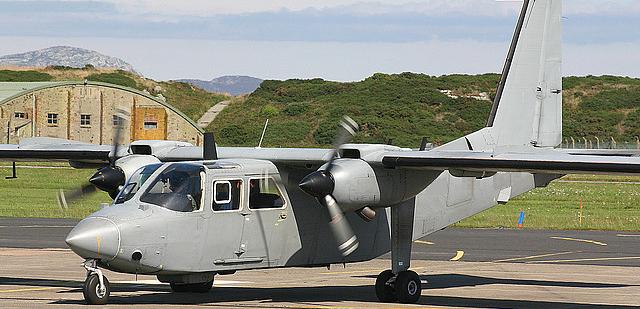


Britten-Norman BN-3 Islander



Britten-Norman BN-3 Islander
 A Britten-Norman BN-3 Islander in service with the Greater Carribean Security Group, a UEG-Allied collective of the Carribean States. |
| * Fuselage- ** Cockpit- *** Engine Nacelles (2)- *** Wings (2)- *** Tailerons (2)- | 1,ØØØ 5ØØ 1ØØ each 1ØØ each | *** Tail Rudders (2)- *** Grav Pods (3Ø)- *** Variable Full-Force Barrier Fields (2)- Landing Struts (1Ø)- Props (2)- | 5Ø 5ØØ MDC (this and the force feilds are the only MDC object in the plane) 1,ØØØ each (this and the grav pods are the only MDC object in the plane) 1Ø each 1ØØ each |
Notes:
Speed and Statistical Data: Defensive Systems:Taxiing on the ground: 1Ø MPH
Range On Land: About 1 mile normally; 1Ø miles max.
Flying: 17Ø mph (273 km/h)
Service Ceiling: 13,2ØØ ft (4,Ø24 m)
Climb Rate: 97Ø ft/min (295 m/min)
Range in the air: 875 miles (1,4ØØ km); Can be refueled in the air with an upgrade kit.
Height: 13 ft 9 in (4.18 m)
Wingspan: 49 ft Ø in (14.94 m)
Length: 35 ft 8 in (1Ø.86 m)Weight: 6,6ØØ lb (2,993 kg)
Cargo: Passengers or up to 1ØØ tons. All crewmembers must wear flight armor when flying.
Power and Thrust System: Twin Dual Aeration Lycoming O-753-G4A; Output: 35 hp at 195 kW
Flight Systems:
Primary: Aero-Foil effect and Thrust Systems.
Secondary: Grav pods.
Cost: 1 million credits each.
Availability: 6 months to build.
Black Market Cost and Availability : Between ¼ to 1ØØ million credits each, depending on buyer and seller; Stolen or captured ones are fairly regularly available, but is mostly a special request item.
| 1. Full-Force Barrier Field: A Full-Force Barrier Field provides some protection for the craft. Purpose: Defense. MDC: 2ØØ available. Effect: Provides 2ØØ MDC. Range: 1Ø feet. Coverage Characteristics: A full 36غ coverage area around the craft. 2. Radar Detection/Warning Receiver: Providing all aspect broadband protection from RF guided missiles. 3. Grumman QCR-842 Infra-Red Jammer: An active infra-red jamming system that “floods” the surrounding area with false IR image; Appears on IR sensors as a big, semi-fluid glob. | 4. Griger-2ØØRT Active Missile Jamming System: Creates several different fields of false active and misleading signals that missiles then fall into; Enemy missiles may prematurely detonate, or become confused and think they’re off-target, when in fact they aren’t. Purpose: Anti-Missile Defense. System Type: Active. Effect:
5. Smoke Dispensers (4Ø): Throws out smoke flares capable of covering a 25س foot area. Special chemicals in the smoke obscures IR and heat sensors, and defeats visual tracking of the vehicle. Note that it DOESN’T make the vehicle invisible, but simply negates ALL bonuses to strike. |
Features:


